
July 2021
Counterrevolutionary
Instigators Exploit Frustration Over Economic Crisis
The Truth About Cuba
Protests
Defend the Revolution Against
U.S. Imperialism and Its Frontmen
Fight for International Socialist Revolution
Break the Blockade – Down with Pandemic Extortion!
U.S., Miami Gusano Mafia: Hands Off Cuba and Haiti!
Mobilize Workers Councils to Defend the Gains of the Cuban Revolution!
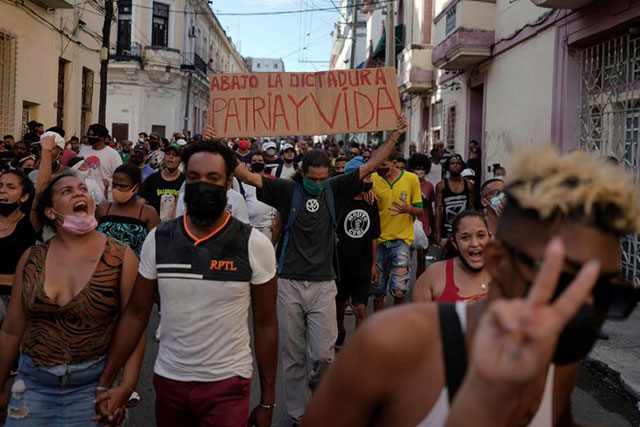
Havana, July 11: Anti-government protests were fueled by economic hardship due to coronavirus pandemic and 60-year-old economic blockade, but were instigated, propagated and exploited by counterrevolutionaries (as can be seen in slogans carried by protester). (Photo: Alexandre Meneghini / AP)
23 JULY 2021 – The protests that took place in several dozen cities and towns of Cuba and locations in and around the capital on July 11 were the biggest anti-government mobilizations since the dawn of the Revolution. While fueled by desperation over food shortages, lack of medicine and blackouts that have beset the island in the wake of the coronavirus pandemic, the marches were instigated, manipulated and exploited by forces seeking to overthrow the Cuban Revolution. With its exemplary public health system, Cuba has been able to contain the virus far better than almost anywhere else on the planet outside of China. Yet U.S. rulers are seeking to capitalize on the economic toll of the pandemic, and weariness from 60 years of imperialist blockade. In this difficult situation, the first duty of revolutionary communists, in Cuba and worldwide, is to actively combat the forces of capitalist counterrevolution.
The imperialist media marveled at the “the apparently spontaneous eruption,” in what it called a “police state,” against the Cuban government’s “failure to protect the population from a failing economy, energy shortages and the ravages of the coronavirus.”1 The virulent exile milieu in Florida, however, took to social media to rant that the protests were not about a virus or shortages but an uprising against “communist rule.” For these gusanos (counterrevolutionary worms), as Florida Senator Marco Rubio tweeted, “People in #Cuba are protesting 62 years of socialism, lies, tyranny & misery not ‘expressing concern about rising COVID cases/deaths’.” It’s absurd to pretend that the people of Cuba yearn for the “freedom” of the 1950s dictatorship of Fulgencio Batista, overthrown by the rebel army led by Fidel Castro on 1 January 1959. But such ravings show what the gusano instigators of the protests are aiming at.
Cuba today is in the deepest economic crisis since the 1990s Special Period after imperialist-led counterrevolution in the USSR cut off its lifeline of Soviet aid. The current shortages, while not as severe as then, have made daily life on the island harrowing, and now the population has internet and smart phones so that interested parties can turbocharge “news,” real or fake. In addition, the counterrevolutionary exile milieu in nearby Florida is itching to provoke disorder in the region in the wake of the defeat of “their” president, Donald Trump, last November. (Miami-based Cuban and Venezuelan gusanos also appear to be intimately involved in the assassination of Haitian president Jovenel Moïse on July 7.) Things could escalate as rightist Cuban Americans in Florida are now talking of dispatching a provocative “freedom flotilla” to lay siege to Havana.
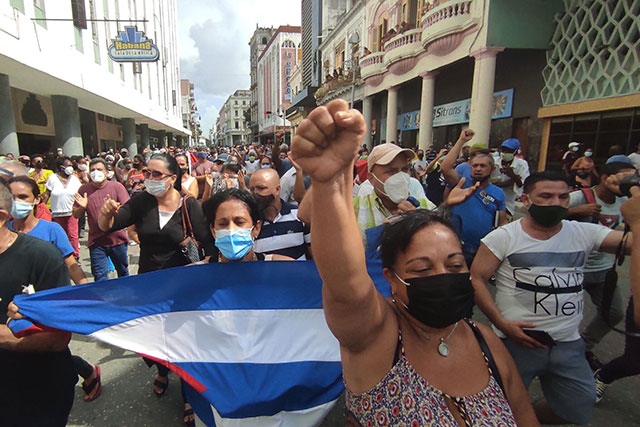
Havana, July 11: Western media didn't report that hundreds of government supporters (above) took to the streets to oppose counterrevolutionary protests, or mislabeled photos as supposedly showing anti-government protesters. (Photo: Yamil Lage / AFP)
The numbers in the July 11 protests were relatively limited, 3,000-5,000 in Havana, a few hundred or a few score each in smaller cities and towns in four of Cuba’s eight provinces. Hardly an uprising. But the fact that they took place in a number of places simultaneously is ominous – while the fact that they occurred in those locations and not elsewhere points to a basic fact. This was not spontaneous. For many participants, it was no doubt a cry of fatigue over shortages, over endless standing in line and all the other hardships Cubans have had to endure for years due to vicious economic blockade. But the protests were a political act, and judging from online videos they were headed up by groups of provocateurs who set the tone; they were spread by a sophisticated internet operation of thousands of automated tweets, and were trumpeted by U.S. imperialist spokesmen, from Republican Rubio to Democrat Joe Biden.
When the reputed “leader of the Free World” – free for capitalist exploitation, that is – vows to “stand with the Cuban people in their clarion call for freedom,” this is a threat of imperialist action. The Miami-based #SOSCuba campaign has been calling for a “humanitarian corridor” to bring aid to island. What they have in mind is something like the (failed) February 2019 siege of Venezuela, orchestrated by the administration of Donald Trump, that tried to invade that country by sea and land under the guise of bringing emergency aid supplies. The July 11 protests were part of the #SOSCuba operation, yet rather than denouncing this cynical ploy, much of the reformist left in the United States (and some in Latin America) fell into line behind Biden, hailing the manipulated protests. Various social-democratic tendencies which sometimes pose as Trotskyists – which they absolutely are not – were among the worst of these imperialist toadies. (We will soon be publishing an analysis of the positions of several of these currents regarding the recent events in Cuba.)
In contrast, in the face of the counterrevolutionary mobilization, the Internationalist Group and League for the Fourth International (LFI) call to defend the Cuban revolution against U.S. imperialism and its frontmen, which highlights the urgency of fighting for international socialist revolution. Against the poisonous talk of a “humanitarian corridor” as a smokescreen for imperialist intervention, we call to break the blockade – down with pandemic extortion. And with Cuba’s socialized economy under siege by anti-communists and endangered by the privatizing policies of the ruling bureaucracy, the Trotskyist LFI calls to mobilize workers councils to defend the gains of the Cuban Revolution!
I. Protests “Made in Miami”
There is no doubt that what fueled the marches were the incredible privations the population has faced in recent months. The food shortages are very real, and a direct result of Cuba’s inability to earn hard (convertible) currency through exports due to the economic blockade, as well as the collapse of tourism in the wake of the pandemic. Likewise, the blackouts were due to electricity generating plants shutting down units for repairs after being unable to import parts. The first protest was in San Antonio de los Baños, just to the west of Havana, sparked by a power outage in the summer heat. The government’s Radio Artemisa put out a detailed schedule for when electrical power would be out for six hours a day in each barrio over the weekend, but then the blackouts extended to 12 hours. On TV on Monday, July 12, the energy minister explained that the units would soon be back on line (which they were by Wednesday), while warning that it could happen again.
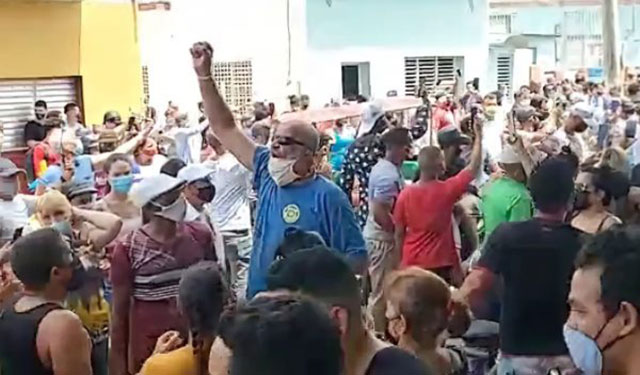 Anti-communists instigated
march in San Antonio de los Baños, July 11. (Photo: Facebook screenshot)
Anti-communists instigated
march in San Antonio de los Baños, July 11. (Photo: Facebook screenshot)In the protest that brought out several hundred in San Antonio, videos show marchers calling for vaccines, as well as chanting anti-communist slogans like “libertad” (freedom), “abajo la dictadura” (down with the dictatorship) and “patria y vida” (fatherland and life) – a counterpoint to the slogan patria o muerte, (fatherland or death), closely associated with the Cuban Revolution. Yet Cuba has done remarkably well in fighting the coronavirus pandemic, sending infected persons to hospitals, isolating contacts and using Cuban-developed Interferon Alpha 2B to treat COVID-19 patients. While numbers of cases and deaths are rising with the appearance of the Delta strain, Cuba’s COVID mortality rate (160 per million people) is less than one-tenth that of the United States and one-sixteenth that of Brazil. Cuba has developed several vaccines and is already administering two with over 90% efficacy against COVID-19, Soberana 2 and Abdala, which began mass distribution on July 9.
Videos of the anti-communist protest in San Antonio have been shown over and over on the internet. What they don’t show is that a couple of hours later there was a second march in San Antonio by several hundred government supporters, including workers from the local tobacco plant. Cuban president and Communist Party (PCC) secretary-general Miguel Díaz-Canel spoke with residents in their homes and addressed the press in the town plaza. He then went on TV, radio and Internet speaking of the shortages of food and medicines, the power outages and the media campaign to discredit Cuba, ending with a call on “all revolutionaries to go into the streets to defend the Revolution everywhere.”2 While denouncing “counterrevolutionaries” who led the protest, the Cuban leader said that the marchers included “people in severe conditions” and even “confused revolutionaries” who were “expressing their dissatisfaction.”
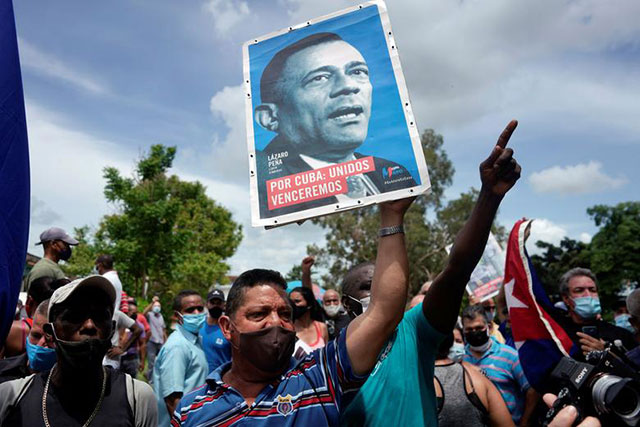
Pro-government march in San Antonio de los Baños on July 11 included workers from the Lázaro Peña tobacco plant, named after historic Cuban union leader. (Photo: Alexandre Meneghini / AP)
The fact that these demonstrations were part of an international operation is attested to by the time line of events. At 12:37 p.m. on July 11, a tweet from Yoani Sánchez, the internet anti-communist celebrity, announces that people are marching in San Antonio. At 12:45, a video shows a speaker in San Antonio calling “down with the dictatorship” and denouncing CP leader Díaz-Canel as a “singao” (roughly, fucker). At 12:56, an alert from the Movimiento San Isidro (MSI)3 to stay tuned “in view of the events in San Antonio de los Baños.” At 1:11, the MSI declares “the people of Cuba are in the streets.” At 1:20, a call from #SOSCuba in Miami to rally at 2 p.m. At 1:22 another anti-communist video from San Antonio. At 1:37, the MSI “call[s] on the organizations of civil society to go into the streets.” At 1:41, MSI founder Luis Manuel Otero Alcántara calls for people in Havana to go to the Malecón seaside avenue. At 1:57, a video of a protest in the city of Palma Soriano. At 1:59 a video from the city of Matanzas of a crowd marching.
No, this was hardly a “spontaneous eruption,” as the media portray it. U.S. agencies have spent heavily for years to use the internet to incite and instigate counterrevolution in Cuba. In 2010, the infamous U.S. Agency for International Development (USAID) set up the botched messaging app ZunZuneo, hoping that as it reached a critical mass, operators would insert “political content aimed at inspiring Cubans to organize ‘smart mobs’ – mass gatherings called at a moment's notice that might trigger a Cuban Spring.”4 What occurred on July 11 was the realization of this project, using Facebook and Twitter. But that still requires “assets” on the ground. Whatever the origin of the original event in San Antonio de los Baños, the second outbreak, in Palma Soriano in eastern Cuba, was clearly the work of counterrevolutionary groups. This city has long been a center of Catholic reaction surrounding the cult of the Virgin del Rosario. It is the stomping ground of José Daniel Ferrer, the public face of the counterrevolutionary Patriotic Union of Cuba (UNPACU) and a paid agent of the U.S. This outfit in 2016 received $99,431 from the rightist Miami-based Cuban American National Foundation (CANF).5
As we go to press, an article has appeared in the gusano digital magazine El Estornudo (22 July), “July 11 in San Antonio de los Baños: What You See/What You Don’t See” (in Spanish), which gives an extremely detailed account, complete with screenshots, about how the first protest was organized. It turns out that this was the work of a Facebook group, “La Villa del Humor,” which has been active in the city – the site of Cuba’s most important military airport – since 2017. The main organizer, who uses the pseudonym Danilo Roque, declared later that “I and my team decided it was time to land the blow, since the government was concentrating on COVID.” On July 10, they put out a call on the Facebook group for a protest next day, using the pretext of the blackouts: “Are you tired of not having electricity? … Time to go out and demand.” This “spontaneous protest” was the work of counterrevolutionary provocateurs.
On July 11, as videos and tweets came online they were pumped out on social media in thousands of messages, which “made intensive use of robots, algorithms and accounts that were recently created for the occasion.”6 The Cuban site CubaDebate (12 July) reported how a Spanish internet analyst, Julián Macías Tovar, documented that the first Twitter account using the hashtag #SOSCuba, by a Spanish user, blasted out 1,291 tweets on July 11 alone and over 1,000 the day before. These were then reposted by other accounts, so that on July 11 there were “hundreds of thousands of tweets, many of them from accounts of artists” about protests in Cuba. A posting by a television reporter in Florida about San Antonio de los Baños was retweeted thousands of times. Moreover, “more than 1,500 accounts that participated in the operation with the hashtag #SOSCuba were created on July 10/11.”
A second analysis, by Mint Press (16 July), cited “NBC’s Director of Latin America, Mary Murray, [who] noted that it was only when live streams of the events were picked up and signal-boosted by the expat community in Miami that it ‘started to catch fire’.” It pointed to “hundreds of accounts tweeting the exact same phrases in Spanish, replete with the same small typos.” One read (in Spanish), “We Cubans don’t want the end of the embargo if that means the regime and dictatorship stays, we want them gone, no more communism.” The article also noted the frequent use of photos of large gusano demonstrations in the U.S. in articles about the (much smaller) protests in Cuba, and of several photos labeled as protesters in Havana but actually showing hundreds of government supporters, such as at the monument to Cuban independence fighter Máximo Gómez where demonstrators held the flag of Fidel Castro’s July 26 movement.
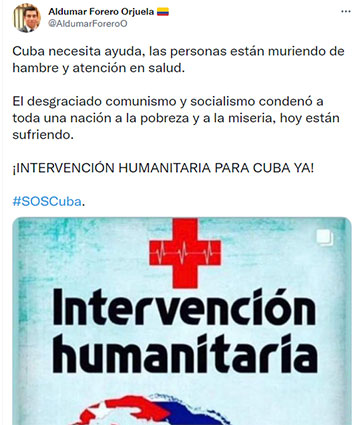 #SOSCuba tweet calling for
“humanitarian intervention” in Cuba. Petition with 430,000
signatures called for U.S. invasion. Miami mayor called for
air war.
#SOSCuba tweet calling for
“humanitarian intervention” in Cuba. Petition with 430,000
signatures called for U.S. invasion. Miami mayor called for
air war. The Mint Press article by Alan MacLeod was titled, “The Bay of Tweets: Documents Point to US Hand in Cuba Protests,” a reference to Democratic president John F. Kennedy’s disastrous April 1961 Bay of Pigs invasion, when Fidel Castro led workers militias and Revolutionary Armed Forces troops in smashing 1,500 U.S.-armed mercenaries. Castro’s response to the invasion was to proclaim that “we have carried out a socialist revolution right under the nose of the United States.” The article also pointed to the 1898 explosion that sunk the USS Maine in the Havana harbor, which the yellow press turned into the pretext for the U.S. war to prevent the victory of Cuban independence forces and wrest the colony from Spain. This time around, a petition on change.org calling for U.S. “humanitarian” military intervention in Cuba has over 430,000 signatures.
Today the imperialist Big Lie propaganda machine is going into high gear to portray the July 11 protests as a popular revolt against communism. The ultra-rightist Cuban exile milieu would like to use them as a pretext for a U.S. invasion, and the mayor of Miami has called for “air war” against Cuba. As Cuban foreign minister Bruno Rodríguez noted in a July 13 press conference, “To call for humanitarian intervention in Cuba is to call for a U.S. military intervention…. A ‘humanitarian intervention’ is what took place in Yugoslavia in 1999,” under Democratic president Bill Clinton.7 That’s what some have in mind for Cuba today. But unlike capitalist Yugoslavia in 1999, Cuba is a (bureaucratically deformed) workers state. When CP leader Díaz-Canel vows that “if they want to overthrow the Revolution, they will have to pass over our dead bodies,” this is hardly abstract. Every Communist Party member is well aware that counterrevolution in Cuba and return of the gusano cutthroats would result in a bloodbath.
II. Cuban “Dissidents” on U.S. Payroll
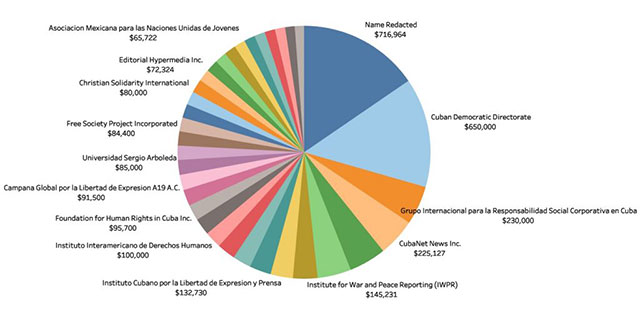
National Endowment for Democracy Cuba grants in 2018. N.E.D. = CIA.
(Graphic: Cuba Money Project)
The Cuban American National Foundation lobby referred to above is a main conduit for U.S. funding of Cuban “democrats.” In 2011, the U.S. Agency for International Development (USAID) gave the Foundation for Human Rights in Cuba, a creation of the CANF, $2 million to foster “empowerment” in Cuba. This was supplemented in 2013 with another $1.44 million to “advocate for community needs, thereby increasing expectations and accountability for improved governance” in Cuba. “Tax records show the organization channeled at least $3,324,741 to Cuban dissidents from 2014 to 2018,” according to the Cuba Money Project, led by Tracey Eaton, the former Cuba correspondent of the Dallas Morning News. In actuality, the CIA, NSA, USAID, N.E.D. (National Endowment for Democracy), State Department and other U.S. agencies spend vast sums every year financing anti-communist subversion in Cuba.
As for the Movimiento San Isidro, journalist Ed Augustin, reporting in the London Guardian (6 December 2020), interviewed an MSI member, Esteban Rodríguez, who described himself as a “social media influencer.” The article noted that “State media has cast the San Isidro movement as US mercenaries.” In fact, it continued: “There is clear evidence that some in the San Isidro Movement have ties with the US government. Esteban Rodríguez works for ADN Cuba, a Florida-based online news outlet that was awarded a $410,710 grant in September from USAID, a US government agency. The US spends $20m annually on anti-government media and ‘democracy promotion’ programmes (which critics say are better described as ‘regime change’ programmes).” Augustin goes on to quote Rodríguez as approving Trump’s tightened sanctions, including blocking family remittances, and saying, “If I was in the US, I’d have voted Trump.”
 MSI leader Denis Solís
shouts “Donald Trump 2020” when Cuban police officer delivers
summons on 7 November 2020, right after U.S. elections that
Trump lost.
MSI leader Denis Solís
shouts “Donald Trump 2020” when Cuban police officer delivers
summons on 7 November 2020, right after U.S. elections that
Trump lost. He isn’t the only Trumper in the MSI. When a Cuban police officer came to the home of Denís Solís González last November 7 to serve a summons to appear in court, the Afro-Cuban rapper filmed the encounter in which, along with homophobic insults, he shouts, “Donald Trump 2020. He is my president.” Solís then posted his video to Facebook. When he was jailed for contempt of court, a protest sit-in was staged at outside the Cuban Culture Ministry on November 27. There were no arrests, and instead the deputy minister held a four-hour dialogue with the protesters, ending with an agreement to meet again. But then a new “November 27 Movement” (N27) sent an email demanding that participants in said meeting include notorious counterrevolutionaries. The ministry replied it would “not meet with individuals who have direct contact with and receive financing, logistical support and propaganda backing from the government of the United States and its officials.”
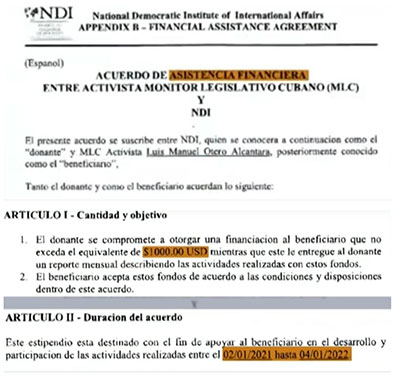 MSI on the U.S.
payroll: Contract between National Democratic Institute and
Luis Manuel Otero Alcántara shown on Cuban TV, April 2.
MSI on the U.S.
payroll: Contract between National Democratic Institute and
Luis Manuel Otero Alcántara shown on Cuban TV, April 2. (Photo: Screenshot from Canal Caribe.)
The main leader of the MSI is Luis Manuel Otero Alcántara, described in the media as a “performance artist.” In April, as he was preparing an “art show” aimed at children consisting of paintings of candy wrappers,8 Cuban television (Canal Caribe) broadcast a program showing a contract between the National Democratic Institute (NDI) and Otero Alcántara for a stipend of “up to $1,000 USD” per month, in exchange for a “monthly report on the use of these funds.” The Cuba Money Project (4 April) reported: “The NDI received at least $6,615,674 for Cuba programs from 2002 to 2021, records show.” The NDI is an affiliate of the N.E.D., which since the mid-1970s replaced the CIA in funding anti-communist “dissidents,” and describes its work in Cuba as “capacity building of independent Cuban civil society actors.”
Another Afro-Cuban rapper speaking for the San Isidro Movement is Maykel Osorbo. In a social media posting that was played on Cuban TV on December 11, Osorbo urged Trump to invade Cuba. He starts by calling to intensify the blockade against Cuba, saying there should be “a real embargo, blocking the coasts, so that nothing comes in, nothing goes out.” Finally, he declares: “I would even support an invasion…. Come on, we’re waiting.” Osorbo and another MSI member co-produced the song “Patria y Vida” – which has become the anti-communist anthem – together with the millionaire hip-hop artist Yotuel Romero and some black reggaetoneros (reggaetón music performers) in Miami. The lyrics, reportedly written by Romero, are a recitation of gusano slogans (“no more lies,” “62 years, your time is over”). The song was then popularized via internet by Yankee imperialism’s powerful media machine, what the CIA called its “Mighty Wurlitzer” (jukebox).9
As Cuba Money Project’s Tracey Eaton told the Mint Press about U.S. funding for artists in Cuba, “It’s impossible to say how many U.S. tax dollars have gone toward these programs over the years because details of many projects are kept secret.” He noted that the State Department, USAID and the U.S. Agency for Global Media all run such programs. For its part, the N.E.D. lists recent projects including “Empowering Cuban Hip-Hop Artists as Leaders in Society” (to “raise awareness about the role hip-hop artists have in strengthening democracy in the region”) and “Promoting Freedom of Expression in Cuba through the Arts.” Since 2017, the USAID has doled out grants of $16,569,889 to “promote democracy” in Cuba, including $4.7 million to the Bacardí Family Foundation just in the last two years, and $20 million to the Grupo de Apoyo a la Democracia, a Miami gusano umbrella group, which then funnels the dollars to subrecipients.10
Clearly, financing counterrevolution in Cuba is a big business. The San Isidro Movement is the current “dissident” darlings for liberals and conservatives alike in the U.S., especially for sparking the July 11 protests. A few years ago, it was the Damas en Blanco (Ladies in White), bankrolled by the CANF. The MSI is a mainly Afro-Cuban group of artists based in the rundown neighborhood of Old Havana for which it is named. It was founded in 2018 to oppose implementation of the Cuban government’s Decree 349 regulating artistic and cultural activities. But the MSI and its supporters in the mainly white November 27 movement are a political movement whose aims go far beyond calls for artistic freedom. The N27 manifesto spells that out:
“2. Economic Freedoms. We affirm the right of every citizen to engage in different forms of economic activity, ownership and management. We value the role of private enterprise and the exercise of economic freedoms that enable the promotion of productive capacities and generate goods and services essential for the development of the nation.”
Not a word about Cuba’s socialized economy, the basis for its great achievements in education, health and medicine, including developing COVID vaccines. The MSI/N27 defense of private enterprise and private ownership of the means of production is a call for capitalist counterrevolution.
One more thing about the San Isidro Movement: Cuban American academic, Javier Corrales, wrote in the N.E.D.’s Democracy Digest (15 December 2020) that the movement was “mounting an attack on the system by placing the issue of racial justice front and center.” Actually, the MSI has said very little about racial equality or discrimination, and this is no accident. The AfroCubaWeb site notes that to do so, it would have to deal with the virulent white supremacy of its backers in Miami. The site also notes that pro-Trump, pro-embargo rapper Solís is also very “pro-Proud Boys, whose leader is an Afro-Cuban.”11 Indeed, Enrique Tarrio, the chairman of the fascist outfit (and a former FBI informant), is a product of the Miami Cuban milieu who spoke to the crowd at the July 11 gusano protest there while holding a banner reading: “Proud Boys, San Isidro Chapter, Down with Díaz-Canel and the Communists.” These sinister facts highlight yet again that promotion of imperialist-backed counterrevolution against the Cuban Revolution goes hand in hand with racist and anti-communist terror here, in Cuba and internationally.
III. Protesters Unleash Violence, Defenders of the Revolution Mobilize
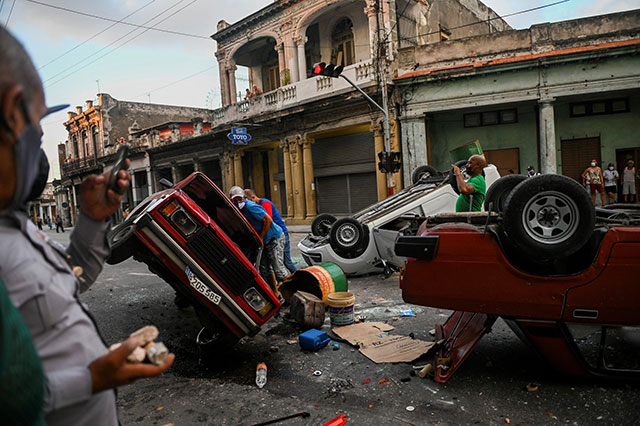
Police cars overturned by anti-government protesters in Havana, July 11. (Photo: Yamil Lage / AFP)
As July 11 wore on, in some places the anti-communist protests in Cuba turned to violence. In Cárdenas, a police cruiser was overturned and an MLC (convertible currency) store looted. Cárdenas, a largely black city in Matanzas province, has been particularly hard hit by the latest COVID-19 outbreak, as many of its residents work in the tourist industry at the Varadero beach resort. In the capital, at two places (both in the 10 de Octubre section of Havana), police cars were overturned and in one case an MLC store was attacked. These were not the same crowds who marched downtown nor did the violence seem to be organized; instead, judging from videos, those involved appeared to be “marginalized” youth from poor barrios lashing out at symbols of authority. Police only arrived in numbers after the fact. Imperialist spokesmen hailed these actions as a sign of anti-regime fervor, whereas they would of course condemn them in the U.S.
Subsequently there has been a hue and cry in the Western
media over police repression of the July 11 protests. Among
those echoing this cynical imperialist propaganda were
“progressive” Democrats Alexandria Ocasio-Cortez (“we
solidarize with [the protests] and condemn the anti-democratic
actions led by President Díaz-Canel”) and Bernie Sanders. For
the most part, the police let marches proceed, until they grew
violent. The Associated Press reported that in Havana: “About
2-1/2 hours into the march, some protesters pulled up
cobblestones and threw them at police, at which point officers
began arresting people and the marchers dispersed.” It was at
that point, as well, that the Communist Party called upon its
membership and supporters to “take to the streets to defend
the Revolution.” Which they did, many chanting “patria o
muerte.” The AP reported: “About 300 people close to the
government then arrived with a large Cuban flag shouting
slogans in favor of the late President Fidel Castro and the
Cuban revolution.”
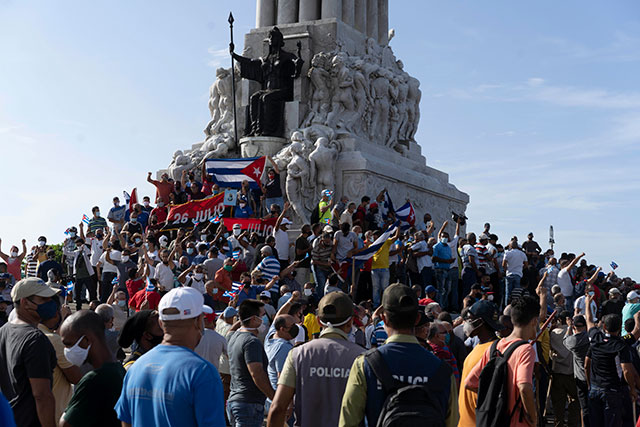
Pro-government demonstrators at monument to Máximo Gómez in downtown Havana, July 11, prominently showing banner of Fidel Castro’s 26th of July Movement. Photolying: Western media used this photo to purportedly show size of anti-government protests. (Photo: Eliana Aponte / AP)
At first, 100-plus pro-government demonstrators took over the Monument to Máximo Gómez, the Dominican general in the Cuban War of Independence who freed the slaves. Photos of this were widely used in Western media as proof of the scale of the anti-government protests when they actually showed the opposite. Photos then show several hundred demonstrators outside the nearby Museum of the Revolution. But as an anti-communist crowd of by now around 2,000 headed toward the Plaza de la Revolución, Communist Youth members and others rushed to head them off. Many quite sensibly carried sticks – good! Photos of this were cited as proof of “repression.” What those accounts don’t show is that defenders of the Revolution were violently attacked by anti-government protesters. Here is one account, from a woman who works at Cuban radio/TV:
“The [anti-government] demonstrators grabbed stones and threw them at two of my friends…. A car came upon us and tried to run us over, at another point one of them pulled out a knife and everyone started running…. A neighbor had to save us, literally. She opened the door to her home, they were throwing stones, bottles.”12
Another account, “from a comrade who was in one of the rallies in defense of the revolution” quoted by the International Marxist Tendency:
“I was attacked…. They almost lynched me, they threw water, rum and they threw two stones at me, though they didn't hit me.”
While, again, many if not most of the anti-government protesters were no doubt expressing frustration and anger over shortages, blackouts and a pandemic that has made their lives miserable, the people in the forefront had an agenda. Those who formed the letter “L” (for Libertad) with their thumb and forefinger as they tried to run down supporters of the Revolution – as racists in the U.S. have done against anti-racist demonstrators – were calling for the capitalist “freedom” to exploit, to oppress and to recolonize the island. When they chanted “down with the dictatorship,” they were calling to replace the workers state (the dictatorship of the proletariat) with the dictatorship of capital. As the protests intensified, their counterrevolutionary thrust becoming clearer by the minute, this was a defining moment: where did you stand? Trotskyists would have joined the pro-government mobilization, appropriately equipped to stop those who would bring back the Yankee imperialists and gusanos.
Subsequently, a massive anti-communist media machine – those directly paid by Washington (Cubanet, ADN Cuba, Diario de Cuba, TV and Radio Martí) and those who claim to be privately financed (CiberCuba 14yMedio), plus liberal and right-wing media in the U.S. – unleashed a barrage of lies about brutal repression. Yoani Sánchez’ 14yMedio was filled with rumors of dead and “disappeared” everywhere. (The one person who died was not during the July 11 protests but the next day, during a provocative attempt to march on a police station in Arroyo Naranjo.) As one can see from photos, the police were not carrying firearms, unlike in the U.S. where thousands of heavily armed cops set upon Black Lives Matter demonstrators. In all, there were 200 or so arrests. In the case of the MSI’s Otero Alcántara, arrested on his way to the Malecón, this was certainly justified for his role instigating counterrevolutionary protests.
One of those arrested on July 11 was Frank García Hernández, who was the main organizer of the 2019 Trotsky Conference in Havana.13 An article titled “On the July 11 Protests in Cuba” (in Spanish) on the Comunistas (17 July) blog that he founded explains that he arrived by chance at a place where there had been violent clashes near the Plaza de la Revolución. The article states that when a police official wrongly accused Maykel González, editor of the gay rights magazine Tremenda Nota, of throwing stones at the police, Frank García sought to intervene as a member of the Communist Party, whereupon both were arrested. After a little over 24 hours in detention, when the authorities clarified the events where neither had participated in violent actions, they were both released. “Frank states that he was NOT subject to any physical mistreatment or torture,” the article reports, adding that “Frank García is not presently under house arrest,” but under a restraining order limiting his movements, a normal procedure there until the initial charges are formally adjudicated.
For all the media coverage of the Monday, July 11 protests in Cuba, there has been hardly a mention of the Saturday, July 17 pro-government “Rally of Revolutionary Reaffirmation” that brought out tens of thousands in Havana, as photos clearly show, and thousands more around the country, far more than the much-publicized anti-government marches five days earlier. In the Saturday rally, Cuban president and PCC leader Díaz-Canel ended with a call, “Viva Cuba, sovereign, independent, socialist!” But while talking of “necessary self-criticism, pending rectification, deep revision of our methods,” of “bureaucracy” and “insensitivity,” and the need to “pay more attention to vulnerable sectors,” his main message was that the Cuban Revolution “wiped out forever the seeds of evil, of hate, of dishonor and crime.” Yet abstract appeals to love and civic virtues are far from the revolutionary communist program needed to defeat a cold-blooded enemy.
IV. Bureaucracy Undermines Gains of the Revolution
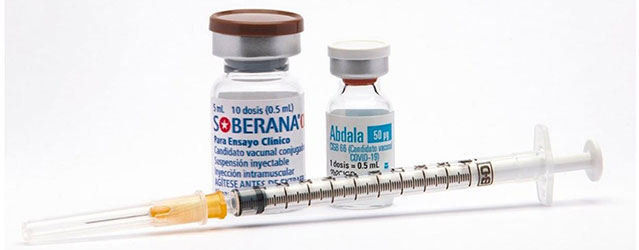
While Cuba has developed two COVID vaccines (Soberana 2 and Abdala) proven to be over 90% effective, imperialists are hoarding vaccines, refusing to send them to Africa as pandemic enters its most deadly phase. (Photo: BioCubaFarm)
As we detail elsewhere (see “U.S. Blockade of Cuba: ‘Bring About Hunger, Desperation, Overthrow’”), the fundamental and immediate causes of the acute economic and medical crisis facing Cuba today lie in the fact that it is a small island under relentless siege by imperialism and subject to the brutal dictates of the world capitalist market. It is grotesque to accuse Cuba’s government of failing to protect the population from the ravages of the coronavirus pandemic when it has in fact done far better than any capitalist country in the hemisphere. Cuba’s development of multiple COVID-19 vaccines is a stunning achievement, especially in the face of the economic extortion to which it has been and continues to be subjected. And such accusations are particularly vile coming from imperialist governments which are literally hoarding vaccines, ensuring that none will be available in Africa, now in the deadliest stage of the pandemic.
By the end of August, the G7 countries will be sitting on 1.9 billion doses more than they need to vaccinate their populations, and “enough to vaccinate the entire adult population of Africa,” according to the ONE Campaign.14 The World Health Organization (W.H.O.) Covax program promised vaccines for poor countries, but shipments simply stopped when India banned exports of the Astra-Zeneca vaccine following the resurgence of the pandemic with the Delta strain earlier this year. One reason Cuba did not join the Covax program (in addition to the fact that it was developing its own vaccines) was concern that in view of the blockade it could be cut off at any point, as all of Africa now has been. For all their cynical professions of concern for the Afro-Cuban population, which has suffered more than any other from the effects of the blockade, the supporters of the blockade now calling for U.S. “humanitarian intervention” should answer for the fact that the would-be imperialist “saviors” are blocking vaccines to black Africa.
Meanwhile, the hard reality is that the effects of the
blockade have also been aggravated by the policies of the
Cuban Communist Party (PCC) leadership, which for the last
decade has sought to open the socialized economy to a “private
sector.” This began with the “Economic and Social Policy
Guidelines” approved at the PCC’s Sixth Congress in 2011.
These Lineamientos were pushed in particular by Raúl
Castro, after taking over from Fidel Castro as Cuban president
three years prior. This mixed bag of measures, some
supportable, others clearly dangerous, included leasing
state-owned agricultural land to private farmers, introducing
private wholesale markets, promoting worker cooperatives,
laying off workers from state enterprises, opening a real
estate market, allowing mobile phones, easing rules for
foreign direct investment, expansion of self-employment (such
as taxis) and small businesses (such as family restaurants),
and abolition of the dual monetary system of convertible and
non-convertible pesos.15
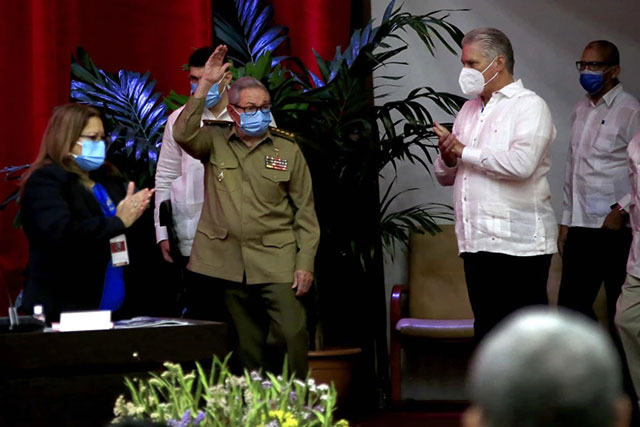
Former Cuban president Raúl Castro stepped down as Communist Party general secretary at PCC Eighth Congress in April 2021, handing reins to Miguel Díaz-Canel (right). Castro has pushed to open Cuban economy to “private sector.” (Photo: Associated Press)
The background to this policy goes back to the origins of the Cuban deformed workers state. Even as the peasant-based guerrillas of the victorious July 26th Movement sought in 1959-60 to carry out a far-reaching agrarian reform, Washington’s economic blackmail pushed them into into nationalizing foreign-owned businesses that dominated the Cuban economy. When the Eisenhower administration banned petroleum sales to Cuba and Esso refused to refine Soviet-supplied crude oil, the petty-bourgeois Castro regime had no choice but to seize the refinery and other U.S.-owned assets. Having been pushed into the arms of the USSR, the Cuban leadership proceeded to build a (bureaucratically deformed) workers state on the model of the latter-day Soviet Union. For three decades the USSR subsidized Cuba, buying sugar valued above the world market price in exchange for oil at below world market prices.
Along with building up a bureaucracy from scratch (in the early years, the Cuban leadership consisted of whoever was sitting in Fidel Castro’s jeep), this also entailed embracing the nationalist program of the bureaucratic regime of Stalin and his heirs.16 Usurping political power upon the death of V.I. Lenin, who together with Leon Trotsky led the 1917 Bolshevik October Revolution, Stalin junked the program of Red October of international socialist revolution on which the Communist International was founded. Instead, placing himself at the head of a privileged bureaucratic layer, he put forward the anti-Marxist dogma of “building socialism in one country.” The Castros embraced this, accentuating a Cuban nationalist outlook while increasingly toeing the conservative Soviet bureaucrats’ line and, after a period of encouraging pro-Cuban guerrillas in Latin America, abandoning them in the 1970s. But with imperialist-led counterrevolution in the USSR and the East European Soviet bloc in 1989-92, Cuba was left on its own.
Since – in the Stalinist framework – international socialist revolution was out, the alternative to bureaucratic mismanagement of the economy was privatizing measures, heightening the danger of capitalist restoration. This was the common thread of Stalinist “reformers” from Khrushchev to Gorbachev in the Soviet Union and Deng in China. So when Cuba was cut off from Soviet aid, after going through the dark days of the Special Period of 1990-9317 when the economy plunged by a whopping 35%, the alternative to bureaucratic stagnation put forward was the policies of growing privatization advanced by Raúl Castro. But although enunciated in 2011, they were only implemented piecemeal, and after 2016 there was backtracking. So in 2018-19, Raúl Castro and Díaz-Canel pushed through a new Constitution, whose Article XXII formally recognizes, along with state property of “the fundamental means of production” (defined as the main form), also “private: which natural or legal persons, Cuban or foreign, exercise over certain means of production.”18
So since 2019 private property of some means of production has a constitutional basis in Cuba, although that has yet to be translated into laws. As the Cuban gusanos and Yankee imperialists certainly recognize, this is hardly the restoration of capitalist class rule – but it is an ominous step that will foster the growth of capitalist inroads and pro-capitalist forces in Cuba, and should be opposed by all revolutionary communists. Now, in the midst of the pandemic, PCC leader Díaz-Canel has been pushing to implement these pro-capitalist reforms. In August 2020, the opening of foreign currency accounts (in state-owned banks) was authorized. At the same time, 72 convertible currency (MLC) stores were opened, where those with an MLC debit card from their bank deposits in dollars or euros can buy goods not available to those who only have Cuban pesos. The government says this was needed to soak up hard currency, but it has made the MLC stores a widely hated symbol of privilege.
In October, a complex of measures supposedly to increase competitiveness was decreed, the so-called Ordering Task (Tarea Ordenamiento), which among other things would eliminate “excessive subsidies” and “inappropriately free goods” and “avoid egalitarianism” (!) instead of “subsidizing people.”19 This is in fact a “neoliberal” reform, in which social policies benefitting all are replaced with welfare measures for the poor. In addition, prices for various products such as milk would be deregulated (except for special categories of the population, such as children). The key measure in the Tarea Ordenamiento was the elimination of the dual monetary system, so that now there would be a single Cuban peso which would be exchanged at the rate of 24 to the dollar. For those who previously had income in convertible Cuban pesos, which had a 1:1 exchange rate with the dollar, this amounted to a 96% devaluation. The minimum wage for workers was quintupled, but the savings of the petty bourgeoisie were effectively wiped out.20
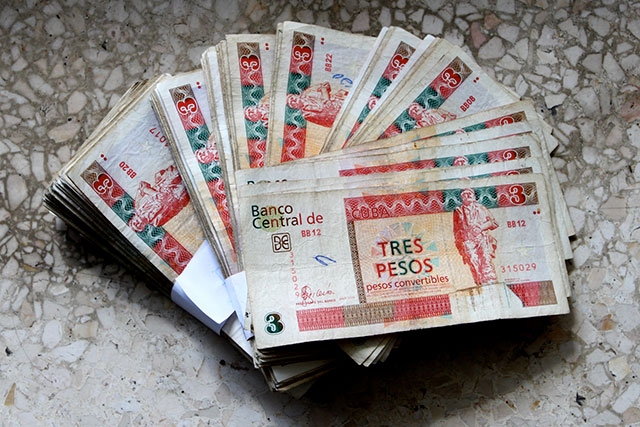
Above: Cuban convertible pesos (CUC). By replacing the CUC with a single convertible peso and devaluing it by 96%, government wiped out savings of petty bourgeoisie and set off inflationary spiral. (Photo: Cuba Money Project)
In short, the Tarea Ordenamiento which took effect on 1 January 2021 implemented many of the privatizing “reforms” that Raúl Castro’s Lineamientos had called for in 2011 but were never or only partially implemented. On top of this, in mid-January the government replaced the list of 127 economic sectors in which private enterprise was allowed with a new list of 124 economic sectors in which it was excluded, everything else being open to private entrepreneurs. This could potentially mean a sizeable expansion of the private sector. But by devaluing the currency and expanding the convertible currency stores at a time of extreme shortages of goods, the result has not been a flourishing of small businesses but a huge increase in inflation, as those with dollars or euros on their tarjeta MLC debit card drive up prices for scarce products formerly distributed with the libreta de canasta básica (ration card).
And it continues: three days after the July 11 protests, Díaz-Canel announced that wages in the state sector would no longer have to be paid according to the official salary schedule. This would “give the management of state enterprises autonomy” so that “those who create more wealth, are more efficient and produce more for the state will earn more.” Hailing this “audacious transformation,” the PCC leader said “the non-state sector has a certain freedom to determine how much will be paid to workers, which we are now incorporating in the functioning and management of the socialist state enterprises.” Eliminating uniform pay scales is an attack on the unity of the working class, and should be opposed by all class-conscious workers as part of defending the socialized economy against the inroads of capitalism and capitalist methods.
In the past, Raúl Castro and some Cuban economists looked to the “Vietnamese model,” but as Díaz-Canel noted last year, Vietnam had not been “subjected to an embargo for six decades.”21 Even though the U.S. lost the Vietnam war, and although there is a sizable Vietnamese anti-communist exile community in the U.S., Washington has allowed American companies to set up shop there while the political apparatus and state sector of the deformed workers state remains intact. It’s about geopolitics. U.S. rulers’ interest in Vietnam is driven by its effort to cordon off China, while Cuba is right in the middle of the U.S. sphere of influence, only 90 miles from Florida in the Caribbean Sea that U.S. rulers since the 19th century have considered an American lake.
With its supposedly “socialist” shock therapy of dangerously pro-capitalist “reforms,” the bureaucratic leadership of the Cuban deformed workers state is promoting measures that foster the growth of counterrevolutionary forces. To be sure, it claims to be upholding the primacy of what is known as the socialist sector (i.e., the state-owned enterprises) and defending the state monopoly of foreign trade, as Raúl Castro said at PCC’s Eighth Congress in April, where he stepped down as general secretary, handing over the reins to Díaz-Canel. But by seeking to assuage the petty bourgeoisie while cracking down on workers and the poor by eliminating “excessive” subsidies, “egalitarianism” and uniform wage scales, the bureaucracy is pushing some of those who should be the solid base of support of the workers state into the arms of capitalist reaction. And the counterrevolutionary forces are every-ready to exploit this, as they showed on July 11.
V.
Defend the Gains of the Cuban Revolution –
Smash the Counterrevolution!
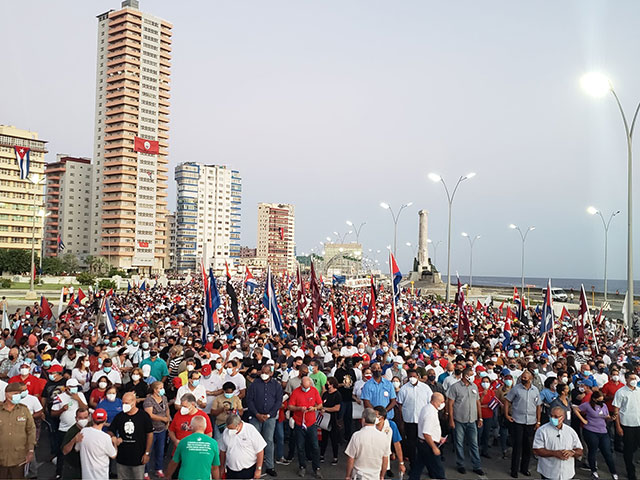
Tens of thousands came out to show support for the Cuban Revolution at July 17 seaside rally in Havana. Column in the background is the remains of the former “Remember the Maine” monument erected when Cuba was a U.S. neo-colony. In 1959, Cuban revolutionaries toppled the monument, which was crowned by an eagle. The eagle must not return. (Photo: Letícia Martínez Hernández) Click on image to enlarge.
While opposing any and all measures that undercut or sabotage revolutionary gains, Cuban poor and working people must intransigently defend the Cuban Revolution against the imperialists, their frontmen, PR agencies and apologists who would drown them in poverty while spouting honeyed phrases about “freedom.” The magnificent achievements of Cuba’s school system that eliminated illiteracy and has educated generations of professionals, its unequaled system of medical care that is the envy of Latin America, its development of a biomedical and pharmaceutical industry capable of developing five COVID vaccines despite the imperialist blockade – none of this would be possible under capitalism. That system based on production for profit rather than human needs guarantees that those on the bottom stay on the bottom, where murderous police violence is unleashed to ensure the dictatorship of racist capitalism.
A program to combat the threat of capitalist restoration should begin with a call to form workers councils to defend the gains of the Revolution, not only against the Yankee imperialists and their Cuban collaborators but also against threats emanating from a bureaucracy which is sabotaging those gains. Rather than increasing the power of managers or carving up entities plant by plant, management of state-owned enterprises should be in the hands of plant/workplace committees joined together in a nationwide assembly of workers in the socialized economy. This could promote innovation and efficiency, not by bureaucratic dictate or market competition, but by energizing the creative capacities of the workers who know the problems better than anyone and can resolve them using their collective power. A start could be made in the electrical energy industry, where workers in the power plants of the Unión Eléctrica and distributed (local) generators could work with local workers councils in dealing with power shortages and promote renewable energy.22
A program for workers defense of the Cuban Revolution should include replacing the MLC stores, which whatever limited use they may be in soaking up dollars and euros (in order to sell goods which themselves must be bought with dollars and euros), have enraged the poor, showcasing the consumer goods they cannot get. Unlike in the 1990s, when only those who received dollar remittances from Cuban exiles could shop there, today many (egged on by counterrevolutionaries) see them as symbols of bureaucratic prerogative. As some protesters yelled at PCC members on July 11, “You are the privileged ones, for sure you have MLC cards, you have food in your homes.” In East Germany, where the Trotskyists fought tooth and nail against capitalist reunification in 1989-90, hard-currency Intershops, along with high-priced Exquisit and Delikat stores, infuriated working people who couldn’t afford to buy there, a fury that was exploited by the counterrevolution.
Yes, there is a terrible shortage of consumer goods. The workers movement should call on China and Vietnam, deformed workers states for which overthrow of the Cuban Revolution would be a direct threat, to massively send high-quality sports shoes, consumer electronics and children’s toys (plus, given current shortages in Cuba, shiploads of rice from Vietnam). This would be a tangible example of international solidarity that could inspire besieged Cuban working people to continue resisting the imperialist onslaught. Calls by Latin American workers demanding that their governments pay top dollar for Cuba’s COVID vaccines could point to a source of badly needed convertible currency to pay for Cuba’s dire food shortages while saving hundreds of thousands of lives from the plague ravaging the continent. To stave off looming disaster in Africa, anti-imperialist protesters should demand that the W.H.O. send Cuba billions of dollars and euros to supply the vaccines that the imperialists refuse to provide.
Also: while the 1959 Revolution brought vast gains for
Afro-Cubans together with the rest of the working people, the
truth is that weaknesses of the Revolution with respect to the
black population have been highlighted by the current crisis,
and are being cynically exploited by the white-supremacist gusanera.
The overthrow of capitalism was an enormous advance for
Afro-Cubans, but the participation of impoverished black
people in violent actions on July 11 is undeniable. Repression
of leading instigators of counterrevolutionary actions is
fully justified. At the same time, it is crucial to launch workers
brigades to repair the rundown neighborhoods of Havana,
Cárdenas and elsewhere. Unemployed local youth
should be enrolled, providing decent wages while working with
residents to reconstruct these long-neglected barrios.
Building vibrant neighborhoods, providing opportunities for
artists to colorfully adorn walls with murals, would inspire
people and undercut the MSI mercenaries who want to entice
children with visions of M&Ms and Chiclets and U.S.-style
bling-laden video fantasies. At the same time, the state must
aggressively prosecute notorious discrimination against
black Cubans in the tourist industry.23
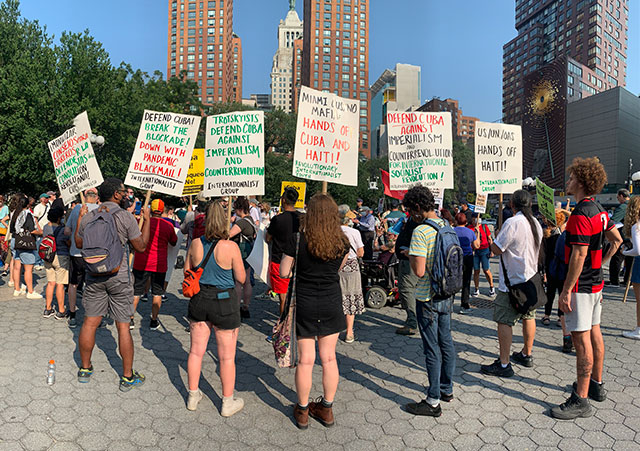
Internationalist Group and Revolutionary Internationalist Youth at July 15 Cuba solidarity rally in New York City. (Internationalist photo)
The fight to defeat the instigators, manipulators and exploiters of the July 11 protests must be waged politically, strategically and above all internationally. Defense of the Cuban Revolution is the task of the world working class, from Latin America to China and the imperialist heartlands in the U.S., Europe and Japan. Faced with the vast power of imperialism, this defense must be able to inspire the masses. The current bureaucratic leadership is incapable of doing so. Those who would write off Cuba, claiming that capitalism has already triumphed, and thus side with counterrevolution; and those who, following in the footsteps of anti-Soviet theorists of old, declare that the brittle, contradictory bureaucracy is itself the “leading force of counterrevolution” and restoration – such pseudo-leftists turn their back on and betray the urgent struggle against the very real imperialist-orchestrated counterrevolutionary forces who exploited the suffering of the Cuban masses on July 11.
U.S. rulers have always had a special hatred of the Cuban Revolution. Under 13 Democratic and Republican presidents they have longed to “avenge” the overturn of their Mafia-infested colonial rule, their humiliating defeat at the Bay of Pigs, Cuba’s role in defending black Angola against imperialist attack, and the very survival of the defiant rebel island they long ago decreed must perish. While Trump added Cuba to the list of supposed state sponsors of terrorism, it is the CIA that sponsored the terrorist Luis Posada Carriles who organized the bombing of Cubana airlines Flight 455 in 1976, killing 73 people. The U.S.’ repeated assassination attempts are vividly depicted in the British documentary, 638 Ways to Kill Castro. In March 2003, terrorists sought to take advantage of the U.S. invasion of Iraq to spark an uprising in Cuba by hijacking two Cuban airliners and then a ferry boat.24 The events of July 11 show that the anti-communist Cold Warriors in Washington will use every opportunity, including the difficulties caused by a plague that has killed hundreds of thousands in the U.S., in their unrelenting war to destroy the “first free territory of America.”
Cuba must not stand alone! The League for the Fourth International calls to build a Leninist-Trotskyist revolutionary workers party armed with a program to intransigently defend the Cuban Revolution against imperialism and internal counterrevolution; to replace the stultifying the bureaucracy (whose pro-capitalist policies increasingly endanger the Revolution) with the soviet democracy of workers councils – that is, a proletarian political revolution to defend and extend the historic gains won in Cuba through international socialist revolution. July 11 was a wake-up call for those determined to defeat the imperialist onslaught. Workers of the world unite to defend Cuba! ■
- 1. “Cubans, broken by pandemic and fueled by social media, confront their police state,” Washington Post, 13 July.
- 2. “La orden de combate está dada, a la calle los revolucionarios,” CubaDebate, 11 July.
- 3. See below for a dissection of this pro-capitalist, pro-imperialist artists group.
- 4. “US secretly created ‘Cuban Twitter’ to stir unrest,” AP, 3 April 2014.
- 5. “Dissident’s arrest triggers debate over funding,” Cuba Money Project, 7 December 2019.
- 6. “Investigación confirma la perversa operación de redes sociales contra Cuba,” CubaDebate, 12 July.
- 7. See “Defend Yugoslavia – Defeat the Imperialist Attack!” The Internationalist No. 7, April-May 1999. The U.S./NATO “humanitarian intervention” led to the forced expulsion of close to 200,000 Serbs and Roma from their homes in Kosovo, the dismembering of Yugoslavia and ultimately the toppling of the Serbian nationalist government of Slobodan Milošević in the first of the U.S.-orchestrated “color revolutions.”
- 8. Otero said the aim of his show was to accuse the government of artificially creating shortages so that Cuban children couldn’t have sweets. But the wrappers he depicts are for Nesquik, M&Ms, Chiclets, Nutella, etc., in other words, for products of huge foreign firms that can only be bought for hard currency.
- 9. On how the U.S. Central Intelligence Agency massively funded “civil society” groups in the anti-Soviet Cold War, see Hugh Wilford, The Mighty Wurlitzer: How the CIA Played America (Harvard University Press, 2008).
- 10. Tracey Eaton, “The democracy business in Cuba is bustling,” Cuba Money Project, 9 December 2021. Eaton also noted that simultaneous with the appearance of the San Isidro Movement, the State Department offered grants of up to $1 million for projects to promote “civil, political, religious, and labor rights [sic] in Cuba.” And now that #SOSCuba has appeared, USAID is offering $2 million for projects to “advance the effectiveness of independent civil society groups” in Cuba (“$2 million up for grabs for democracy projects in Cuba,” Cuba Money Project, 3 July). See also “Democracy, Inc.,” Cuba Money Project, 4 June, for a rundown of some of the main “democracy” money mills.
- 11. “Movimiento San Isidro – N27,” AfroCubaWeb.
- 12. “Testimonies from July 11: When the Violence Was Unleashed” (in Spanish), CubaDebate, 15 July.
- 13. See “The Havana Trotsky Conference: Notes of a Participant,” The Internationalist No. 57, September-October 2019.
- 14. “Africa’s Covid Crisis Deepens, but Vaccines Are Still Far Off,” New York Times, 16 July; and “Data dive: The astoundingly unequal vaccine rollout,” One.org, July 2021.
- 15. See Vegard Bye, Cuba, From Fidel to Raúl and Beyond (Springer, 2020) for a detailed discussion.
- 16. See the Internationalist Group Class Readings, Cuba: A Bureaucratically Deformed Workers State (August 2010)
- 17. See our article “Cuba in Peril,” published in Workers Vanguard No. 585, 8 October 1993, when it was the voice of revolutionary Trotskyism. It is reprinted in Cuba: A Bureaucratically Deformed Workers State.
- 18. See Nueva Constitución de la República de Cuba (2019).
- 19. “What Is New for Workers in the Tardea Ordenamiento?” (in Spanish), Opciones (13 December 2020).
- 20. Díaz-Canel effectively took over the program of bourgeois economist Carmelo Mesa-Lago in his monograph, The Cuban Economy: The Current Crisis, Its Causes, and Policies for the Future (2020) whose recipe for economic reform began with “Carry out monetary and exchange-rate unification” and “Carry out a comprehensive price reform.”
- 21. “Monetary Unification Will Help Stabilize the Economy,” EFE, 25 January.
- 22. Environmental Defense Fund, The Cuban Electrical Grid (2017).
- 23. See “‘A powder keg about to explode’: Long marginalized Afro Cubans at forefront of island’s unrest,” Washington Post, 19 July. Also: “Blacks and the Cuban Revolution,” Workers Vanguard No. 585, 8 October 1993, reprinted in Cuba: A Bureaucratically Deformed Workers State.
- 24. See our article, “For Revolutionary Internationalist Defense of Cuba!” The Internationalist No. 16, May-June 2003. Also, “Decades of U.S. Biowarfare Against Cuba,” in the same issue.
“Cuba Is Being Accused of Many Things – Let’s Fact Check Them”
